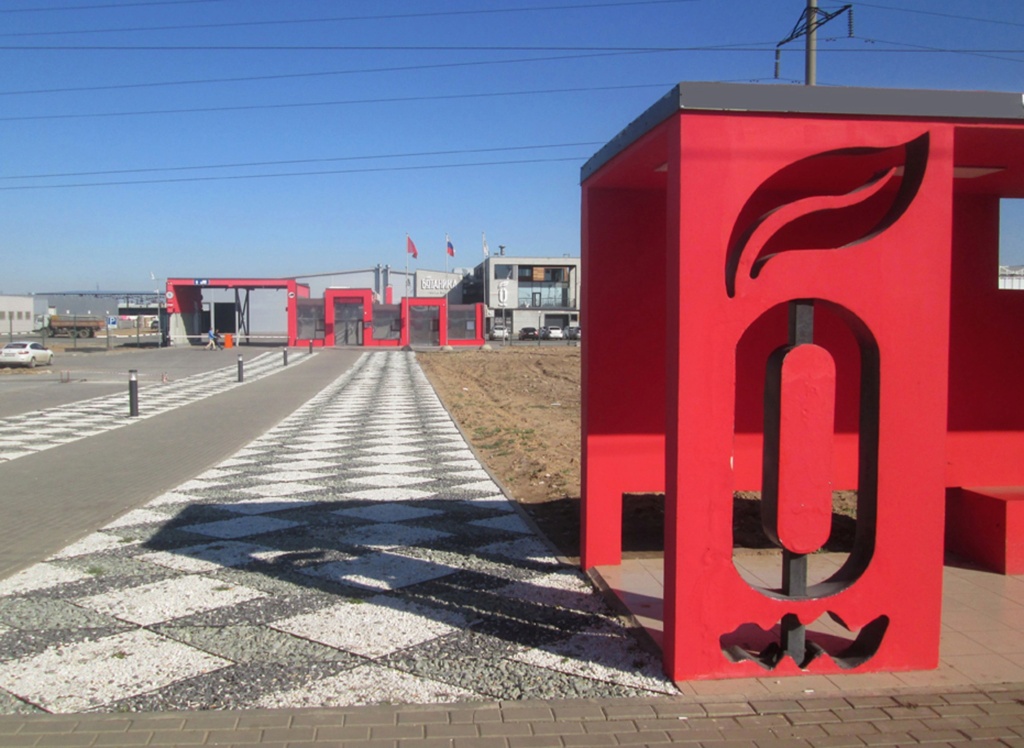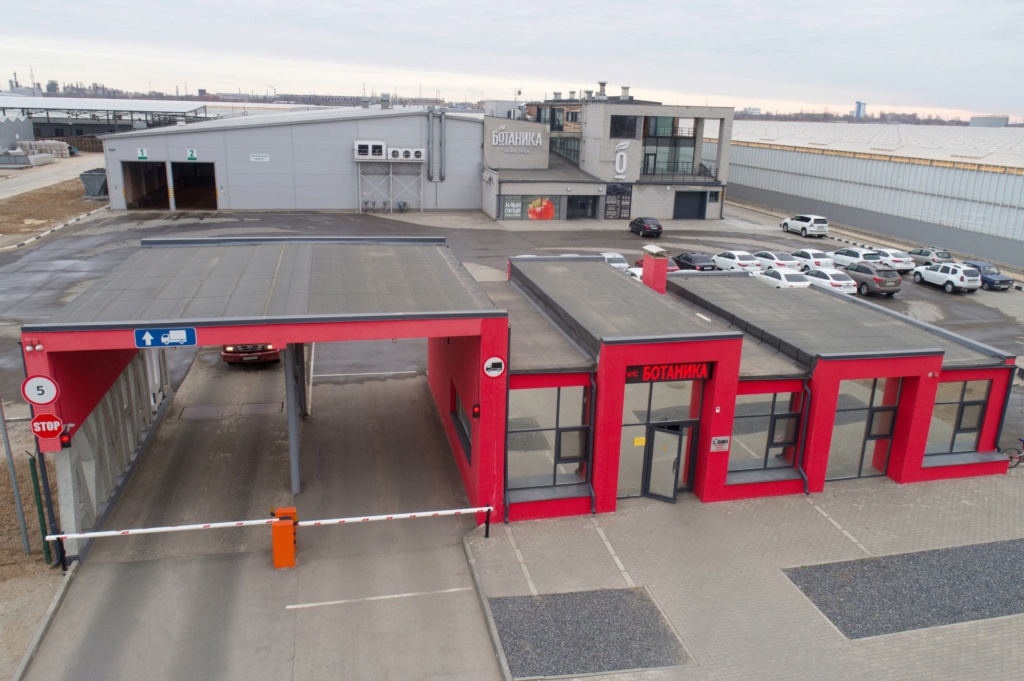Getting something so obvious right does not make them good at what they are supposed to be doing, which should be keeping their readers informed and clearly instead they have just been part of the anti Russia noise coming from the general direction of the west.
Russian Agriculture News

GarryB- Posts : 40541
Points : 41041
Join date : 2010-03-30
Location : New Zealand
- Post n°426
 Re: Russian Agriculture News
Re: Russian Agriculture News
Getting something so obvious right does not make them good at what they are supposed to be doing, which should be keeping their readers informed and clearly instead they have just been part of the anti Russia noise coming from the general direction of the west.
flamming_python and kvs like this post

owais.usmani- Posts : 1825
Points : 1821
Join date : 2019-03-27
Age : 38
- Post n°427
 Re: Russian Agriculture News
Re: Russian Agriculture News
GarryB, xeno, kvs and miketheterrible like this post

kvs- Posts : 15857
Points : 15992
Join date : 2014-09-10
Location : Turdope's Kanada
- Post n°428
 Re: Russian Agriculture News
Re: Russian Agriculture News
since the USSR included Ukraine, Belorus and Kazakhstan. Russia's current territory includes a vast amount of non-agricultural
land.
https://www.nature.com/articles/sdata201856


ALAMO- Posts : 7499
Points : 7589
Join date : 2014-11-25
- Post n°429
 Re: Russian Agriculture News
Re: Russian Agriculture News
Trying to find the one I saw a month or so back
You can find that info seeking for Russian forestry business. The point is, that "deforesting" which is a widely spread agenda, exists only in spoiled minds.
Most of the "deforesting" processes are agricultural land, left untouched 30 years ago.
Now, those are brought back to production, in mass, and libedra is yapping how the evil putinists are destroying precious Russian forestry heritage.
Band of clouns, morrons, and kuklovods in charge ...
By the way, Soviet agricultural technology used to be developed enough, that they planted wine in around of Peter, 40 years ago - and it worked.
This is just another huge lost of the potential, needed to be restored before one can make a step forward.
flamming_python likes this post

Hole- Posts : 11121
Points : 11099
Join date : 2018-03-24
Age : 48
Location : Scholzistan
- Post n°430
 Re: Russian Agriculture News
Re: Russian Agriculture News
The problems in the 70´s and 80´s had nothing to do with agriculture as such but with missing grain silos and transport infrastructure. There were a lot of record harvests back then with no trucks or trains ready to transport the stuff to where it was needed or store it properly.
GarryB and lancelot like this post

GarryB- Posts : 40541
Points : 41041
Join date : 2010-03-30
Location : New Zealand
- Post n°431
 Re: Russian Agriculture News
Re: Russian Agriculture News

Russian_Patriot_- Posts : 1286
Points : 1300
Join date : 2021-06-08
- Post n°432
 Re: Russian Agriculture News
Re: Russian Agriculture News
GarryB, medo, zardof and Scorpius like this post

kvs- Posts : 15857
Points : 15992
Join date : 2014-09-10
Location : Turdope's Kanada
- Post n°433
 Re: Russian Agriculture News
Re: Russian Agriculture News
GarryB wrote:Storage infrastructure and transport infrastructure are both critical to agriculture... no point in growing if you can't store and transport it to the markets you want to feed...
The USSR had decades and vast command economy resources to deal with this aspect. Instead I heard endless excuses about
how the weather in the USSR was not good enough. Obviously that was a lie.

ALAMO- Posts : 7499
Points : 7589
Join date : 2014-11-25
- Post n°434
 Re: Russian Agriculture News
Re: Russian Agriculture News
Part of that was a pure sabotage.

GarryB- Posts : 40541
Points : 41041
Join date : 2010-03-30
Location : New Zealand
- Post n°435
 Re: Russian Agriculture News
Re: Russian Agriculture News
You can grow a crop to maturity, but if you can't store it properly or transport options are limited because something else is tying up the available trucks or trains or ships then that crop will rot.
Things have to be coordinated and working together as a system or it is all for nothing.

Kiko- Posts : 3888
Points : 3964
Join date : 2020-11-11
Age : 75
Location : Brasilia
- Post n°436
 Re: Russian Agriculture News
Re: Russian Agriculture News
MOSCOW, September 15 - RIA Novosti, Natalia Dembinskaya. After more than two months of boycotting, the largest champagne producers from France are returning to the Russian market. But with the labels "sparkling wines" - in accordance with the labeling rules. The "unacceptable" conditions turned out to be quite acceptable after all. What forced the French to resume supplies and why the champagne is now only Russian - in the material of RIA Novosti.
We got into the bottle
Since July, France has not supplied sparkling wine to Russia. The Champagne Provincial Committee, uniting growers and winegrowers (Comité Champagne, CIVC), outraged the new norms of Russian legislation.
The fact is that in Russian, only wine made in Russia can now be called "champagne". This does not apply to the French label with the brand in the Latin alphabet, but the information sticker on the back of the bottle should speak of "sparkling".
The French took this as an insult. Comité Champagne said that such a label "does not provide clear and open information to Russian consumers about the origin and characteristics of the wine."
"Residents of Champagne call on French and European diplomacy to try to change this unacceptable law," co-presidents of the committee Maxim Tubara and Jean-Marie Bariier were indignant.
As a result, deliveries to Russia, according to the industry committee, were suspended "at least 95 percent of trading houses." Among them is the premium Moet Hennessy, which owns the brands Veuve Clicquot and Dom Perignon. Later, however, they agreed to label the products as "sparkling wine". And the pause in sales was explained by the need to make the necessary changes.
Gathered at the WTO
The European Commission also expressed dissatisfaction. The French government has threatened to file a complaint with the World Trade Organization (WTO).
The Ministry of Agriculture offered to explain to the European partners the meaning of the innovations. However, no one requested consultations from the WTO.
"We're just shocked," admitted Charles Guemaer, CEO of Comité Champagne. Producers "were unable to export the champagne despite orders," and suffered financial losses, he noted. Replacing labels on ready-to-ship bottles would be a "complex technical and financial challenge".
Three French ministers at once - economy, agriculture and foreign trade - sent letters to Moscow asking to suspend the law for at least a year.
Back down
In fact, Russia is not a key sales market for French champagne producers. According to the CIVC, they exported 2.6 billion euros ($ 3.07 billion) in 2020. The main buyers are Great Britain, USA and Japan. And only every tenth bottle of sparkling wine on the shelves of our stores is from France.
However, I do not want to lose this either. "Champagne sends to Russia about one and a half million bottles a year - half a percent of exports. But this is an image market, where our champagne is very much appreciated," stressed Jean-Marie Barillier, co-chairman of the committee.
In general, after two and a half months, the French surrendered. The Champagne Wine Committee canceled the recommendation to suspend exports to Russia. From September 15th, deliveries are resumed. The threats to complain to the WTO also died down.
"We will respect the new law ... In addition, we do not want to put Russian clients at an even more disadvantageous position as the New Year holidays approach," Barier said.
French manufacturers "brought their point of view to the Russian authorities, but they will not act to the detriment of consumers." However, according to Bariier, "the battle is not over yet and may be long." How exactly the French are going to fight Russian legislation is not yet clear, but it is obvious that their chances of winning are slim.
https://ria.ru/20210915/shampanskoe-1750027259.html

Kiko- Posts : 3888
Points : 3964
Join date : 2020-11-11
Age : 75
Location : Brasilia
- Post n°437
 Re: Russian Agriculture News
Re: Russian Agriculture News
MOSCOW, September 27 - RIA Novosti, Svetlana Baeva. Russian manufacturers are again among the world winners . Our cheeses turned out to be no worse than French ones, although they made it to the prestigious international salon Mondial du fromage 2021 and the competition in Tours (France) with some problems. As a result, two gold, three bronzes, and the struggle was between 845 types of noble product. About why it is not easy to travel to a pandemic, whether ours are really good, as well as about cheese gastronomy in Russia - in the material of RIA Novosti.
Cheeses-medalists
After the embargo was imposed, many lamented: how to get foreign cheese? Now, it seems, they will hunt for ours. Recently, Russian cheese makers took gold and bronze in France at a prestigious competition (by the way, two of our wineries have recently entered the prestigious world top 50). The trip to the competition was not without adventures, and preparation for it lasted six months. But to try the medal-winning cheeses, you don't need to cross borders. The best are here, next to them.
"The competition for dairy products at the Mondial du fromage 2021 salon is practically the only platform in Europe where producers from any country can present their creations," says Alexey Andreev, a member of the International Guild of Cheese Makers. "An international high-level event."
The salon and competition are held every two years, and this is not the first time that Russians receive awards. In 2019, they won two gold and one bronze.
There are more winners this year. Gold medal in the category of soft cow cheeses with mold - "Black Pyramid" from "Fromage de Louis" from the Voronezh region. Among the soft goats with mold - at Bre'ArDi from Dinara Aristova from the Kaluga region (based on brie and with truffle).
The bronze medal in the category of pressed boiled cheese made from cow's milk was taken by "Gruyere Patrice Norman" from "Eco Village" from the Yaroslavl region. By the way, he was recognized as the best in Russia in 2021. “Well, I also have two bronzes - in the categories of soft goat with mold and sheep,” Andreev smiles (his personal artisan cheese-making dairy is in the Tula region).
Long road to Tour: I wanted to cry
Probably, there would have been more rewards, but the pandemic prevented. The cheese was selected very carefully. In July, in his Tula region, Alexey Andreev organized a competition among various manufacturers, and professional chefs from Moscow, including two Frenchmen, tasted it. The winners, as well as "The Best Cheese of Russia" went to France for the salon. And the adventure began.
“My wife and I flew, we bought tickets with a stopover in Istanbul. There is a lot of luggage, including a bag of cheeses - 27 kilograms, to participate in the competition, to treat guests,” says Alexey Andreev.
Visas, entry permits, which is not easy now, were prepared in advance. But Andreev's wife in Istanbul was "turned off" at customs - they were forbidden to fly to France. The bag with the precious cargo was registered on it, and almost 30 kilograms of cheeses returned to their homeland.
“I flew to France, went into a ten-day quarantine, during which we still wanted to somehow deliver the contestants,” continues Alexey. “The officials tried to help us, right up to the Trade Representation of Russia in France.”
As a result, five kilograms - eight cheeses - broke through to the salon.
"In what condition they were ... Honestly, when they were taken out of the bag, I wanted to cry," recalls the cheese maker.
Alexei himself took part in the world championship among fromomagers, or cheese sommeliers, representing Russia for the first time at this prestigious skill competition. According to the results of the competition, he became the fifth out of nine participants.
Fromager is not only a cheese sommelier, as this French word is often translated in Russia, but also a manufacturer, sales expert, presentation expert, that is, one who knows everything about the product. “I had to participate in blind tastings at the championship, answer questions and offer the best combinations of products (I couldn't do without red fish and caviar). I even made edible sculptures,” says Andreev.
Where to taste the winners
It is almost impossible for Russian tourists to get to France now, but it is quite possible to taste the cheeses marked by the jury. For example, at festivals - one in mid-September was held in Kaluga.
"In December there will also be another cheese festival, so do not plan anything, we are waiting for you," they invite to the Fromage de Louis cheese dairy.
You can also get into production. For example, Dinara Aristova at the beginning of the year held a master class with tasting for summer residents. They cooked halloumi, ricotta, Adyghe, chechil, suluguni, mozzarella, burrata.
“We don't allow tourists to visit us, we have a very small production. But once a month we try to have an open day and treat them,” Andreev says. “Where there are farms with animals, cows, goats, for example, and production, they often accept guests."
A cheese dairy from the village of Podgory of the Samarskaya Luka nature reserve shared the details of the visit of a foreign tourist who appeared during the pandemic. "We had an Italian Marco visiting us. He called our grandmother Signora! I did not understand a word in Russian, but his wife translated for us - Caciotta is very similar to Italian. And he also bought a whole head of Feta along with the uniform." So not only the French are surprised by Russian cheeses.
Wineries are not lagging behind. For example, during an excursion to "Abrau-Dyurso" at the very end, guests see the production of cheese behind a glass wall. You can buy it right there - in the company store, and taste it in a nearby restaurant. Cheese and wine are a popular combination for both giants and small farms. And, of course, the classics are for gourmets.
How much is it
Not far from Pereslavl-Zalessky, you can get to the farm and cheese dairy of Maria Koval, learn a lot of new things and try nine cheeses, paying 600 rubles. Master classes are also held there. The cost is five thousand for groups of two to ten people.
In the Istra cheese dairy of Oleg Sirota, the price of excursions is from 2000 per group (up to 20 people), another 100 rubles is worth tasting. You can come and visit a half-hour free tour.
The main thing is to make an appointment in advance.
Excursions with a transfer, visiting a cheese factory and neighboring tourist sites, tasting and tea are more expensive - on average, from 1,700 rubles. But this is a whole weekend tour.
The cheeses themselves, as a rule, are sold at a price of 2,000 rubles per kilogram. It all depends on the manufacturing technology, ripening period, milk (cow is the cheapest, and sheep is more expensive).
And if the sanctions are lifted?
The rapid development of farm cheese production in Russia began with the introduction of counter-sanctions and embargoes. Many cheese makers came to a new job without seeing the usual products on the shelves. But even if all restrictions are canceled, this should not interfere with the masters.
Experts explain that industrial cheeses were imported to us. There is no need to compare the layer of handicraft products with those that were delivered in tons, wagons. So the high-quality farm cheese that the Russians have tasted will remain on the shelves and in restaurants. And participation in international competitions will continue.
https://ria.ru/20210927/syr-1751664690.html
GarryB, kvs, Hole and Russian_Patriot_ like this post

Kiko- Posts : 3888
Points : 3964
Join date : 2020-11-11
Age : 75
Location : Brasilia
- Post n°438
 Re: Russian Agriculture News
Re: Russian Agriculture News
Russia has reached new food records, and this time they concern not the quantity, but the quality of the new crop. What kind of food culture are we talking about, how is global warming helping domestic agriculture - and what opportunities do Russia have to influence other countries thanks to this?
In Russia, this year , the maximum share of milling wheat was revealed in recent years, its quality turned out to be a record for the entire history of observations. The final figures for the harvest of early grains indicate that more high-quality wheat of I, II and III classes were harvested than low-quality wheat of IV class and fodder grain of V class.
Grain is smaller, but it is of high quality
The usual criticism of Russian crop production and wheat cultivation, in particular, sounds like this: "Russia grows feed grain." A second nonsense is often added to this: "And bread in Russia is also made from fodder."
Bread in Russia is not made from feed grain: this is not allowed by the GOST for bakery flour. Although fodder is indeed constantly present in the Russian wheat crop. The thing is that the conditions for growing wheat in Russia are far from ideal. Most of the agricultural land in our country is located in the zone of risky farming, in which even high-quality wheat is already a gift, and corn, soybeans or sunflowers do not grow at all.
On the other hand, no one grows wheat of the V class (namely, it is called "fodder" and is used for livestock feed). Forage is simply the rejection of ordinary wheat, which did not pass according to GOST in the I-IV classes, which are considered food. Depending on climatic and weather conditions, seed material, correct agricultural practices, application of mineral fertilizers and the result of the work of pesticides and insecticides, the share of feed wheat may fluctuate in different years.
The class is determined, in particular, by the ratio of protein and gluten in the grain.
Moreover, the yield also affects the class of the resulting wheat: the higher the yield, the more likely it is that the plants simply will not "stretch" the ripening of high-quality grain - and most of the harvest will roll into fodder, losing quality. And, of course, where the climate is better and warmer in general, the quality of grain is higher on average. In particular, when harvesting wheat in France, the proportion of high quality grain is an order of magnitude higher.
This year, the grain harvest in Russia is expected to reach 127 million tons. This is quite at the level of the harvests of recent years, when the country annually collected 120-130 million tons. Recall that in 1998 this figure set an absolute anti-record - then only 48 million tons of grain were harvested throughout Russia, so a considerable path has been covered. Due to this, the main factors for improving the quality of Russian wheat were two points: the purposeful efforts of Russian agrarians and the gradual improvement of the Russian climate, which together made it possible to achieve impressive results in the quality of today's wheat. More evidence that global warming is on Russia's side.
In fact, for the first time in modern Russian history, in general, the share of milling wheat (I-IV classes) accounted for a record 87.5% of the harvest. For comparison, in past years, which were already much better than the catastrophe of the late 1990s, the average share of food wheat was much more modest - only 73.5%.
But even more interesting is the division within the classes of milling wheat: according to the results of the acceptance of grain of the 1st class, 0.02% was revealed, the 2nd class - 0.1%, the 3rd class - 45.7%, and the 4th class - 41.7%. Thus, this year, even more class IV wheat was harvested for high-quality class III wheat, which is used to a limited extent for the production of bread, mainly for cereals and pasta.
And yes, through simple mathematics, one can understand that this year the share of feed wheat in the Russian harvest is unprecedentedly small - only 12.5%. And this despite the fact that usually a good quarter of the harvest is of fodder quality.
All this has a direct financial dimension. The higher the class of wheat, the higher the prices for it. Of course, wheat pricing is not limited to this parameter alone, but in any case, Russian farmers can already thank themselves and nature for additional profits. This, however, is not the only benefit.
What does it give Russia
Few people already remember, but throughout the 1990s and early 2000s, Russia was critically dependent on imports of food and, to be honest, even grain used to make bread. For these needs, it was even necessary to start up foreign loans and loans from the IMF, the situation with food security was so threatening.
In 2004, President Putin, realizing this problem, launched a state program for the development of agriculture - along with other national projects aimed at stimulating financing and creating production. Within the framework of this program, an understandable goal was set: to achieve 80–95% self-sufficiency in the main food categories. And, I must say, now, after almost two decades, the result of this program is quite visible and weighty.
Over the years, the production of wheat, like all cereals, has practically tripled. Today, Russia collects 72 million tons of wheat, which brought it to third place in the world after China (131 million tons) and India (about 100 million tons). Even in the USA today less wheat is harvested than in Russia - only 51 million tons, and in Canada, from where the USSR constantly received dry cargo grain carriers with wheat - and even less, only 32 million tons. Already in 2016, having saturated the domestic market, Russia switched to the export of wheat, and next year for the first time it overtook the traditional world leaders in grain export - the USA and Canada, and it still holds this leadership.
Moreover, food exports have become for Russia not only a source of hard currency and budget revenues, but also a political instrument. For example, the deal between Russia and Saudi Arabia on oil production, which led to the formation of the OPEC + mega cartel in 2016, had another dimension. Subsequently, it turned out that the oil deal with Riyadh included the supply of Russian wheat and barley for the needs of the kingdom. With Moscow's help, Saudi Arabia not only achieved stable oil prices, but also solved its food problems by opening its huge grain market to Russian products.
Russia is now responsible for 15% of the kingdom's grain imports, reliably tying Arab sheikhs to its wheat and barley.
Turkey has found itself in a similar situation, which can no longer provide its growing population with its own food. In 2019, Turkey became the largest importer of Russian wheat, but a little earlier it agreed to the construction of the Turkish Stream gas pipeline and the unconditional transit of Russian gas to Europe after Bulgaria refused. Coincidence? Perhaps...
A simple conclusion follows from this: for Russia, the export of grain and, in particular, the most valuable grain crop - milling wheat, has long become a factor of "soft power". In the end, here our country is only copying the successful experience of the United States, which throughout the twentieth century actively used food exports as an instrument of their foreign policy.
And, most importantly, modern Russia does not repeat the sad experience of the Russian Empire in exports, where the maxim “we will not eat, but we will take out” prevailed. Now the export of food is the second task after the food security of the country is closed completely and with a margin.
https://m.vz.ru/economy/2021/10/8/1123091.html
dino00 likes this post

Scorpius- Posts : 1574
Points : 1574
Join date : 2020-11-05
Age : 37
- Post n°439
 Re: Russian Agriculture News
Re: Russian Agriculture News
In short, the best classes of grain in the USA correspond to about 2 classes of grain in Russia. The USA also allows the presence of insects and harmful impurities in grain, while in Russia such grain will not be allowed for sale.
GarryB and kvs like this post

kvs- Posts : 15857
Points : 15992
Join date : 2014-09-10
Location : Turdope's Kanada
- Post n°440
 Re: Russian Agriculture News
Re: Russian Agriculture News
Scorpius wrote:https://pandia.ru/text/77/197/86147.php
In short, the best classes of grain in the USA correspond to about 2 classes of grain in Russia. The USA also allows the presence of insects and harmful impurities in grain, while in Russia such grain will not be allowed for sale.
The usual story. All things Russian are deprecated and smeared while all things American (and friends) are hyped and extolled.
The rampant conversion to GMO produce in the US and Canada is treated as some sort of innovation instead of fail. Aside from
the invisible effects at the molecular scale resulting from screwing around with plant DNA, there is obvious change in the quality
as well. Store bought tomatoes new feature literal wood fiber (white in colour and hard to cut) in them. My memory is not so bad
and I do not recall such features back in the 1980s. This has nothing to do with the tomatoes being picked while green. Green
tomatoes are edible after frying or other preparation. They are not woody.
Some can dismiss the above as a choice of aesthetics. Not so fast. Changes in the organic chemistry of plants is laden with risk
since new types of intermediate chemical species can result during the regular cell metabolic processes. No organic compound can
be assumed safe until proven unsafe. The vast majority of the time it is guilty until proven innocent. These chemicals are not
simple toy blocks to assemble into pre-school structures. They have to have the right geometry to function properly in the
biochemical reaction pathways. Omega-6 industrial seed oils (aka vegetable oils) are an example of what naive "these are all
edible oils" "thinking" gets you. Direct mitochondrial damage.
Scorpius likes this post

Scorpius- Posts : 1574
Points : 1574
Join date : 2020-11-05
Age : 37
- Post n°441
 Re: Russian Agriculture News
Re: Russian Agriculture News

Growth of average grain yield over a five-year period in Russia: comparison between the periods 2000-2004 and 2016-2020.
(measurement in hundredweight per hectare. Hundredweight = 0.1 metric tons, hectare = 10000 m2)
https://www.dairynews.ru/news/zolotaya-osen-rosselkhozbank-nazval-glavnye-trendy.html
GarryB, kvs and Hole like this post

Scorpius- Posts : 1574
Points : 1574
Join date : 2020-11-05
Age : 37
- Post n°442
 Re: Russian Agriculture News
Re: Russian Agriculture News
Of these,
Wheat was threshed from an area of 27.3 million hectares, 76.7 million tons of grain were threshed.
Barley was threshed from an area of 7.8 million hectares, 18.6 million tons were threshed.
Corn for grain was threshed from an area of 1.3 million hectares, 6.4 million tons were threshed.
Rice was threshed from an area of 94.9 thousand hectares, 613.3 thousand tons were threshed.
Sugar beet was excavated from an area of 635.5 thousand hectares, 24.4 million tons were dug up.
Flax-long-tailed from an area of 34.5 thousand hectares.
Sunflower was threshed from an area of 6.9 million hectares, 11.2 million tons were threshed.
Rapeseed was threshed from an area of 1.5 million hectares, 2.8 million tons were threshed.
Soybeans were threshed from an area of 1.9 million hectares, 3.3 million tons were threshed.
Potatoes in agricultural enterprises and peasant (farm) farms were removed from an area of 236.2 thousand hectares, 5.2 million tons were accumulated.
Vegetables in agricultural enterprises and peasant (farm) farms were removed from an area of 139.3 thousand hectares, 3.6 million tons were harvested.
Sowing of winter crops was carried out on an area of 15.3 million hectares.
https://mcx.gov.ru/ministry/departments/departament-rastenievodstva-mekhanizatsii-khimizatsii-i-zashchity-rasteniy/industry-information/info-khod-vesennikh-polevykh-rabot/
GarryB, medo, kvs, PapaDragon, zardof and Hole like this post

Kiko- Posts : 3888
Points : 3964
Join date : 2020-11-11
Age : 75
Location : Brasilia
- Post n°443
 Re: Russian Agriculture News
Re: Russian Agriculture News
This year, Russian farmers have harvested a record harvest of fruits and berries in the organized sector (excluding personal subsidiary plots of the population) - over 1.5 million tons. This is 17% more than last year (1.3 million tons). According to analysts, by 2025 the figure will grow to 2.2 million tons.
The increase in production volumes is primarily due to the high pace of planting nurseries and modern intensive orchards. In 2021, more than 13.2 thousand hectares of perennial plantations will be planted, which is higher than the target of the State Program of the Agro-Industrial Complex.
The development of the sub-industry is facilitated by the activity of investors and government support measures, including incentive subsidies for the establishment and maintenance of perennial fruit and berry plantations, preferential investment and short-term lending, compensation for direct costs incurred for the creation and modernization of agricultural facilities. One of the key tasks for the further development of horticulture is the creation of competitive varieties of fruit crops, strengthening the scientific and human potential, providing farmers with affordable high-tech special equipment and modernizing infrastructure facilities.
https://sdelanounas.ru/blogs/144846/
GarryB, flamming_python, dino00 and kvs like this post

Scorpius- Posts : 1574
Points : 1574
Join date : 2020-11-05
Age : 37
- Post n°444
 Re: Russian Agriculture News
Re: Russian Agriculture News
Of these, wheat was threshed from an area of 27.8 million hectares, 79 million tons of grain were threshed. Barley was threshed from an area of 7.9 million hectares, 18.9 million tons were threshed. Corn for grain was threshed from an area of 2.9 million hectares, 16 million tons were threshed. Rice was threshed from an area of 187.6 thousand hectares, 1.2 million tons were threshed.
Sugar beet was excavated from an area of 992.2 thousand hectares, 40.8 million tons were accumulated.
Flax-long-tailed from an area of 39.3 thousand hectares.
Sunflower was threshed from an area of 9.6 million hectares, 15.8 million tons were threshed.
Rapeseed was threshed from an area of 1.6 million hectares, 3 million tons were threshed.
Soybeans were threshed from an area of 3 million hectares, 4.9 million tons were threshed.
Potatoes in agricultural enterprises and peasant (farm) farms were removed from an area of 273.3 thousand hectares, 6.8 million tons were accumulated.
Vegetables in agricultural enterprises and peasant (farm) farms were removed from an area of 176.1 thousand hectares, 5.2 million tons were harvested.
Sowing of winter crops was carried out on an area of 18.4 million hectares.
https://mcx.gov.ru/ministry/departments/departament-rastenievodstva-mekhanizatsii-khimizatsii-i-zashchity-rasteniy/industry-information/info-khod-vesennikh-polevykh-rabot/
So, for the eighth year in a row, Russia collects more than 100 million tons of grain. Let me remind you that in 1998 the gross grain harvest in Russia amounted to only 47.8 million tons. While now Russia has reached the level of yield corresponding to the 1970-1980 years, despite the fact that the share and quality of wheat is even higher now.
GarryB, franco, Big_Gazza, kvs, miketheterrible, Hole, Kiko and like this post

Kiko- Posts : 3888
Points : 3964
Join date : 2020-11-11
Age : 75
Location : Brasilia
- Post n°445
 Re: Russian Agriculture News
Re: Russian Agriculture News
Russian agriculture is on course to lead the global food market starting in 2025, showing steady growth while the global agro-industrial complex is still recovering from the Covid-19 pandemic, analysts say.
“We can see a serious [post-Covid-19 pandemic] decline in the global agro-industrial complex, where our country is showing good growth dynamics. Russian farmers can take leading positions in the world food market,” political analyst Alexei Martynov said this week, as cited by Prime.
According to Martynov, the sanctions introduced by Europe against Russia in recent years have had the opposite effect to what was intended. The Russian government was forced to shift its focus to the development of the domestic food industry, embracing a policy of import substitution, boosting state support for the agro-industrial complex, and restricting some food imports. These steps have already borne fruit, the analyst said, with agriculture becoming one of the cornerstones of the nation’s economy.
According to the UN Food and Agriculture Organization, the number of people facing food shortages due to the pandemic has increased by 132 million over the past year and a half. Given this, Martynov believes that in the years to come, the importance of the agro-industry will increase, driven by population growth and changes in the climate. Russia, he says, has great potential to boost its agricultural production due to modern technology and digitalization, as well as achievements in breeding and genetics. According to him, all of this largely neutralizes the industry risks faced by other countries.
Despite the difficult weather conditions that weakened the harvest of potatoes and vegetables, this year has mostly been successful for Russian farmers. For the third year in a row, the country produced more than 120 million tons of grain, set records in the collection of oilseeds, fruit, and berries, and increased the production of sugar beets, buckwheat, and other products.
The situation is similar with livestock. Outbreaks of bird flu and African swine fever have cut the volume of poultry and pigs, but the overall volume of meat production is expected to be near last year’s figures, while milk production is expected to reach an 11-year record.
“If you look at the global picture – the widespread cuts in production, the closure of large agricultural enterprises due to the pandemic, disruption of supply chains and food shortages, then in the conditions of this ‘imperfect storm’, our country is in a favorable position. Russians will not face the problem of empty shelves or reduced variety of products. On the contrary, competition and supply of quality products are on the rise,” Martynov said.
However, Russian farmers are short on machinery, which is a problem that should be dealt with immediately.
“Russia will certainly be able to dominate the global food market by 2025, but only if we are active and begin to comprehensively develop the agricultural sector in such areas as the renewal of the agricultural machinery park,” Alla Vysotskaya, head of the Vozrozhdenie Agro-Industrial Complex, said, noting that amid the pandemic, food security has become a more critical matter than ever before. She said that, according to statistics agency Rosstat, there are three tractors and two combine harvesters per 1,000 hectares of land in Russia – while, for example, India has 12 tractors for the same area, and the US has 27.
https://www.rt.com/business/542879-russia-to-lead-global-food-market/
GarryB, flamming_python, Big_Gazza, zardof and owais.usmani like this post

owais.usmani- Posts : 1825
Points : 1821
Join date : 2019-03-27
Age : 38
- Post n°446
 Re: Russian Agriculture News
Re: Russian Agriculture News
dino00 likes this post

Autodestruct- Posts : 148
Points : 150
Join date : 2021-10-04
- Post n°447
 Re: Russian Agriculture News
Re: Russian Agriculture News
according to statistics agency Rosstat, there are three tractors and two combine harvesters per 1,000 hectares of land in Russia – while, for example, India has 12 tractors for the same area, and the US has 27.
OK, but is that with respect to farmable land or not? There are millions and millions of hectares in Russia where the optimal number of tractors is precisely zero.
GarryB likes this post

kvs- Posts : 15857
Points : 15992
Join date : 2014-09-10
Location : Turdope's Kanada
- Post n°448
 Re: Russian Agriculture News
Re: Russian Agriculture News
Autodestruct wrote:
according to statistics agency Rosstat, there are three tractors and two combine harvesters per 1,000 hectares of land in Russia – while, for example, India has 12 tractors for the same area, and the US has 27.
OK, but is that with respect to farmable land or not? There are millions and millions of hectares in Russia where the optimal number of tractors is precisely zero.
It is apples and oranges. Russia does not have the small farms with small tractors that India has. So an agricultural land based comparison
is meaningless. The Russian figure actually shows the efficiency of Russian agriculture. Tractors are not a bottleneck in Russia.
GarryB and miketheterrible like this post

Krepost- Posts : 786
Points : 788
Join date : 2021-12-07
- Post n°449
 Re: Russian Agriculture News
Re: Russian Agriculture News
owais.usmani wrote:
Another hate report/article.
Due to poor weather conditions, grain (wheat, barley, rye etc.) harvest was indeed down this year compared to a record 2020. But it is very much in line with the 2019 harvest.
On the other hand:
- Sunflower harvest: 2021 was a record
- Soybean: 2021 was record
- Rapseed: 2021 was a record
- Fruits: 2021 was record
- Corn: 2021 was second best year ever
Overall, not a record year but certainly not a bad one. There will plenty of wheat, sunflower oil, soya etc. available for export.
Check here: https://sdelanounas.ru/blogs/145254/
GarryB, medo, dino00, Big_Gazza, kvs, zardof, miketheterrible and like this post

GarryB- Posts : 40541
Points : 41041
Join date : 2010-03-30
Location : New Zealand
- Post n°450
 Re: Russian Agriculture News
Re: Russian Agriculture News
Another hate report/article.
Due to poor weather conditions, grain (wheat, barley, rye etc.) harvest was indeed down this year compared to a record 2020. But it is very much in line with the 2019 harvest.
The use of language is abysmal these days....
Normally worst is reserved for bad, but for a straight As student their worst score might be 98 percent, so saying it was their worst subject is a little misleading as it suggests they weren't any good at it... which the actual numbers show they are.
More importantly... how much food does the EU import from Russia at the moment? I thought the Russian EU food embargo was made reciprocal by EU countries so Russian food production numbers wont seriously effect the situation in the EU anyway.


 owais.usmani
owais.usmani




